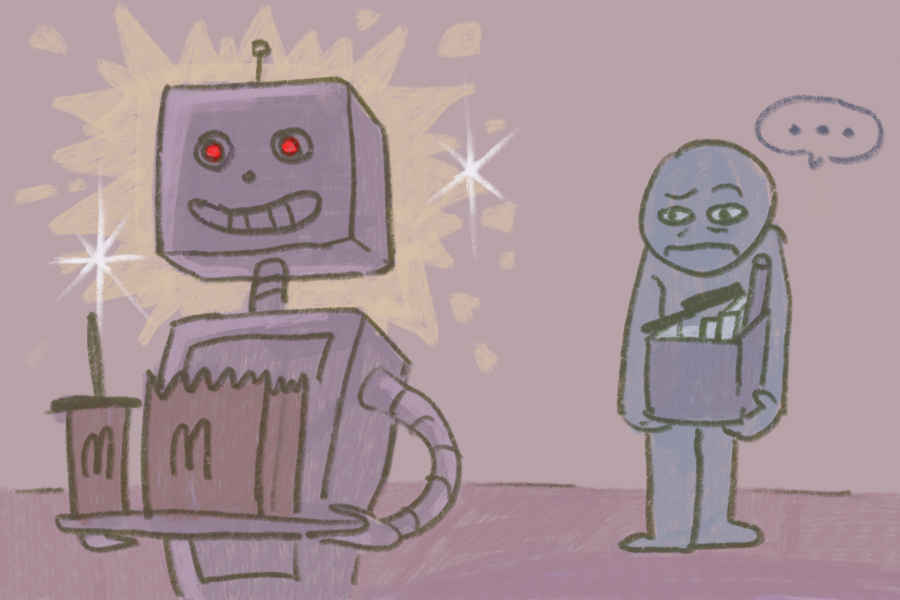The new automated fast food workflow is a dangerous sign of corporate greed amidst a cost-of-living crisis.
Working people and college students alike have long subsisted on customer service, whether that be in retail or fast food. So how would we survive if that was no longer an option? Well, a pilot test location for McDonald’s in Fort Worth has endeavored to answer that question with a setup that takes front end workers out of the equation entirely. A corporate blog post from December claims that the new restaurant is “designed for customers on the move.” Despite this assertion, McDonald’s goes to extreme lengths to prove that there is only one thing new about this establishment: it takes another wage out of the bottom line and paves the way for future automation.
“Inside the restaurant, there’s a delivery pick-up room for couriers to retrieve orders quickly and conveniently,” the blog post said. “There are also kiosks, where customers can place their orders to go, and a pick-up shelf for orders. Outside the restaurant, there are several parking spaces dedicated to curbside order pick-up, as well as designated parking spaces for delivery drivers.”
This is a convoluted way of saying there is nothing really revolutionary about the design. Don’t let the loaded language confuse you. Pickup and drive-thru ordering are already popular enough to become a focus for McDonald’s, especially since the pandemic. So, what is so time saving about picking up your order from a conveyor belt instead of getting it from a pickup shelf?
Proponents of automation may bring up the introduction of conveyor belts to sushi restaurants, where it promises increased efficiency and fewer server wages. But even conveyor belt sushi restaurants usually have human servers and clean-up staff, someone to provide a friendly welcome to the customer’s eating experience. Automation may save money, but not enough to remove humans from the picture entirely, because the customer experience ultimately suffers. There’s one other change to the workflow that jumps out. Not only are there fewer workers, but the few that remain are conveniently hidden from sight. Efficiency aside, this model also segregates the establishment’s employees from the public so effectively that they are essentially invisible. And there’s no way to know if people are getting overworked if you can’t even see them. We at least know that the owner’s stance on employee treatment is clear.
“The technology in this restaurant not only allows us to serve our customers in new, innovative ways, it gives our restaurant team the ability to concentrate more on order speed and accuracy, which makes the experience more enjoyable for everyone,” franchisee Keith Vanecek said in the blog post.
Cashiers serve a vital purpose in many industries. They give a face to the brand image with a smile, and most importantly, bridge the backstage workers to the outside world. Humans are not machines. We run on social contact, not electricity. You can’t just put someone in a closed off room and have them serve food to a conveyor belt. Many restaurants have leaned into takeout while still keeping a human presence at the counter. It isn’t impossible to have both. Unless, of course, you care more about profit than the mental health of your employees. Sorry, humans aren’t machines. But the corporate world sure treats service workers like they are.
Over the past 10 years, remote and app orders have become widespread in fast food and other industries. When I worked retail, I thought it was an advantage — that it could make the job of employees easier by saving the time spent in a social interaction. But corporations don’t push technology like this because they genuinely want to make customer service jobs easier. Obviously, there is an immediate bonus of cutting costs through efficiency. But more importantly, it lays the groundwork to phase us out of the workforce entirely.
We will eventually approach the point where computers or AI are cost-effective enough to replace some customer service employees entirely. Under the lens of money saving, this seems to make sense. After all, companies will always choose the cheapest option. But this undervalues the true role of customer service, which is right in the name. Customers will always prefer a human face to an LCD screen, and it is difficult to put a price tag on consumer satisfaction.
Maybe it’s just a coincidence, but it seems fitting that this establishment comes in December 2022, after the Great Resignation, when the labor force has shrunk more than ever. You might ask, so what? If people don’t want to work, then we have to replace them somehow. But the truth is that amongst a cost of living crisis, people desperately want to work. Employers just don’t want to pay. If Americans refuse to work for minimum wage, some companies would rather double down and take us out of the equation.
So, please. If you’ve ever had a customer service job, don’t feed the robots. Eat somewhere that takes care of its employees, not one trying to erase them from the workforce.






